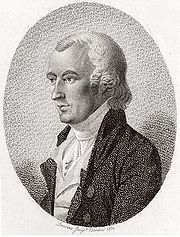
Carl Ludwig Willdenow
Encyclopedia

Germany
Germany , officially the Federal Republic of Germany , is a federal parliamentary republic in Europe. The country consists of 16 states while the capital and largest city is Berlin. Germany covers an area of 357,021 km2 and has a largely temperate seasonal climate...
botanist, pharmacist
Pharmacist
Pharmacists are allied health professionals who practice in pharmacy, the field of health sciences focusing on safe and effective medication use...
, and plant taxonomist
Taxonomy
Taxonomy is the science of identifying and naming species, and arranging them into a classification. The field of taxonomy, sometimes referred to as "biological taxonomy", revolves around the description and use of taxonomic units, known as taxa...
. He is considered one of the founders of phytogeography
Phytogeography
Phytogeography , also called geobotany, is the branch of biogeography that is concerned with the geographic distribution of plant species...
, the study of the geographic distribution of plants. Willdenow was also a mentor of Alexander von Humboldt
Alexander von Humboldt
Friedrich Wilhelm Heinrich Alexander Freiherr von Humboldt was a German naturalist and explorer, and the younger brother of the Prussian minister, philosopher and linguist Wilhelm von Humboldt...
one of the earliest and best known phytogeographers.
Willdenow was born in Berlin
Berlin
Berlin is the capital city of Germany and is one of the 16 states of Germany. With a population of 3.45 million people, Berlin is Germany's largest city. It is the second most populous city proper and the seventh most populous urban area in the European Union...
and studied medicine
Medicine
Medicine is the science and art of healing. It encompasses a variety of health care practices evolved to maintain and restore health by the prevention and treatment of illness....
and botany
Botany
Botany, plant science, or plant biology is a branch of biology that involves the scientific study of plant life. Traditionally, botany also included the study of fungi, algae and viruses...
at the University of Halle. He was a director of the Botanical garden
Botanical garden
A botanical garden The terms botanic and botanical, and garden or gardens are used more-or-less interchangeably, although the word botanic is generally reserved for the earlier, more traditional gardens. is a well-tended area displaying a wide range of plants labelled with their botanical names...
of Berlin
Berlin
Berlin is the capital city of Germany and is one of the 16 states of Germany. With a population of 3.45 million people, Berlin is Germany's largest city. It is the second most populous city proper and the seventh most populous urban area in the European Union...
from 1801 until his death. There he studied many South America
South America
South America is a continent situated in the Western Hemisphere, mostly in the Southern Hemisphere, with a relatively small portion in the Northern Hemisphere. The continent is also considered a subcontinent of the Americas. It is bordered on the west by the Pacific Ocean and on the north and east...
n plants, brought back by the explorer Alexander von Humboldt. He was interested in the adaptation of plants to climate, showing that the same climate had plants having common characteristics. His herbarium
Herbarium
In botany, a herbarium – sometimes known by the Anglicized term herbar – is a collection of preserved plant specimens. These specimens may be whole plants or plant parts: these will usually be in a dried form, mounted on a sheet, but depending upon the material may also be kept in...
, containing more than 20,000 species, is still preserved in the Botanical Garden in Berlin
Botanical Garden in Berlin
Botanical Garden in Berlin is considered one of the most important gardens in the world, with area of 43 hectares and around 22,000 different plant species.The garden is located in the Dahlem neighborhood of the borough of Steglitz-Zehlendorf...
.
He is most famous for his synthesis of European plant geography, and his mountains origins theories.
In 1801, he was elected a foreign member of the Royal Swedish Academy of Sciences
Royal Swedish Academy of Sciences
The Royal Swedish Academy of Sciences or Kungliga Vetenskapsakademien is one of the Royal Academies of Sweden. The Academy is an independent, non-governmental scientific organization which acts to promote the sciences, primarily the natural sciences and mathematics.The Academy was founded on 2...
.
The standard botanical author abbreviation
Author citation (botany)
In botanical nomenclature, author citation refers to citing the person who validly published a botanical name, i.e. who first published the name while fulfilling the formal requirements as specified by the International Code of Botanical Nomenclature...
Willd. is applied to plants he described.
Works
- Florae Berolinensis prodromus (1787)
- Grundriß der Kräuterkunde (1792)
- Berlinische Baumzucht (1811)
- Linnaei species plantarum (1798–1826, 6 volumes) Botanicus
- Anleitung zum Selbststudium der Botanik (1804)
- Enumeratio plantarum horti regii botanici Berolinensis (1809)
- Hortus Berolinensis (1816)

